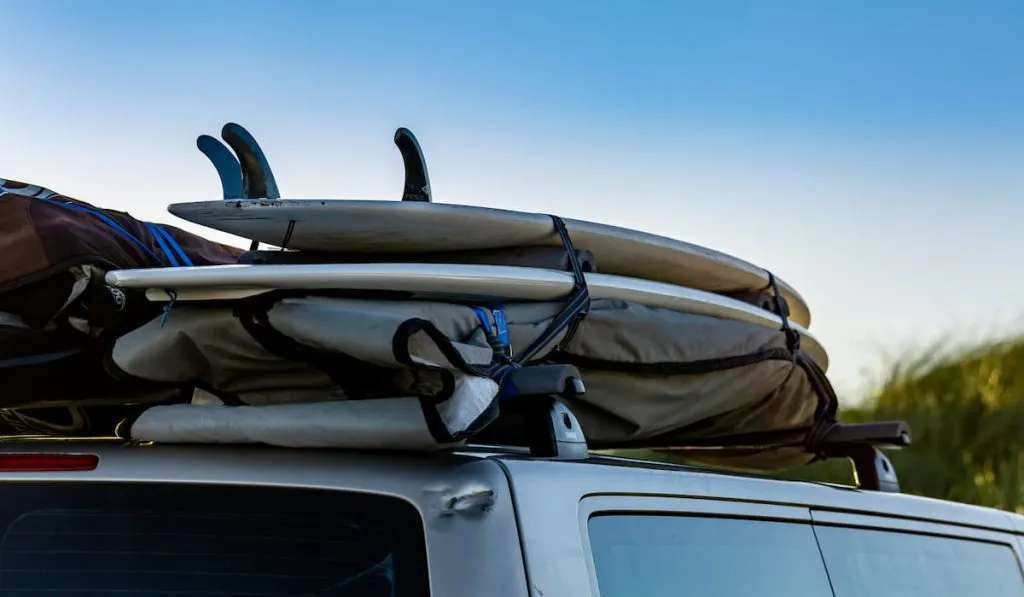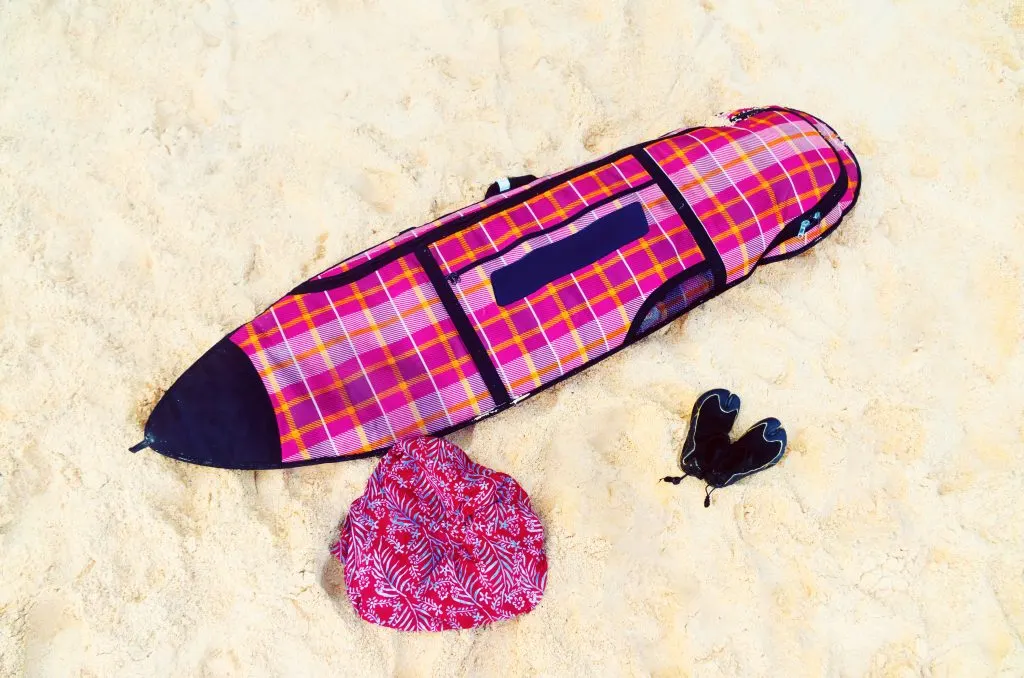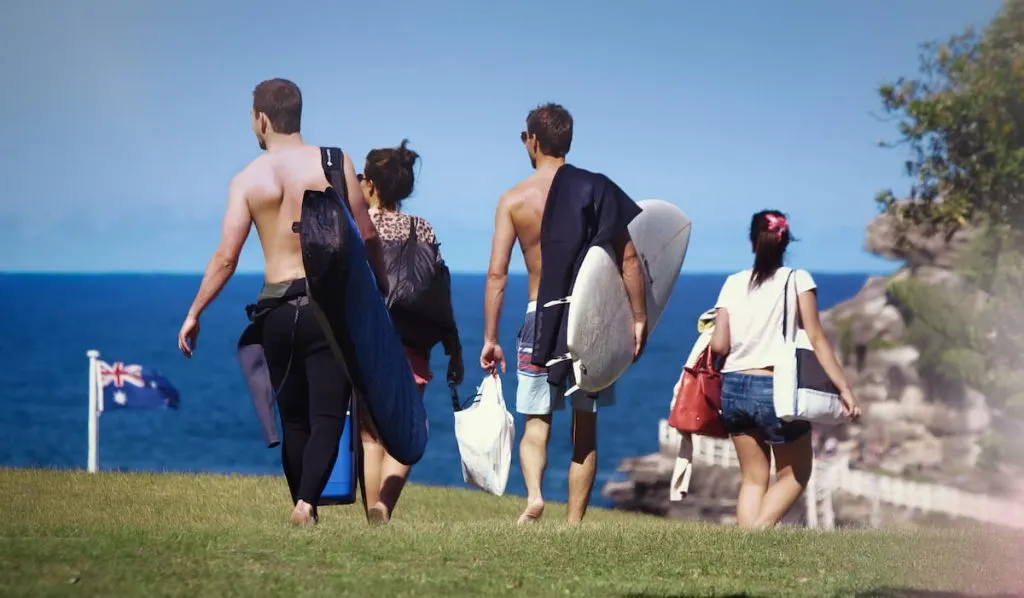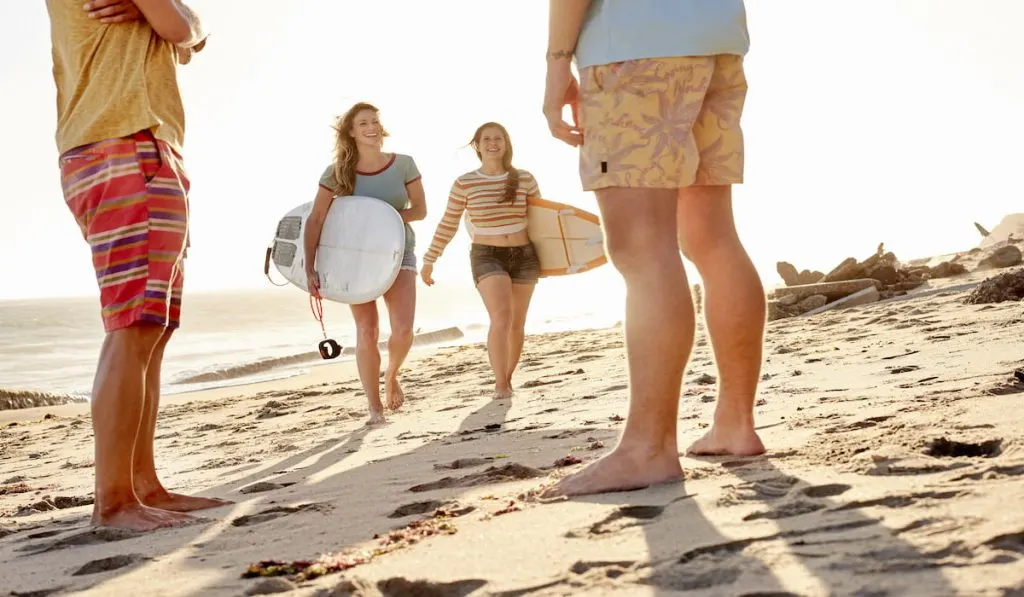Surfboards are typically durable – at least to the point of supporting the weight of the surfer. But they may still deteriorate when exposed to sunlight, impact, and even debris.
This vulnerability is not something you would want to deal with early into owning a surfboard.
Do I need a surfboard bag?
Surfboard bags are undeniably useful in maintaining surfboards. These bags help protect surfboards from gradual photodegradation. They also help ensure that people can travel with their surfboards without worrying about damage through impact. Besides these functions, surfboard bags can serve as a means for surfers to store their belongings.

In this article, we will explore types and benefits of using a surfboard bag. We talk about why they are vital and how you can choose the best option for yourself.
Types of Surfboard Bags
Surfboard bags come in three different types with travel and day-use bags being the most common.
Here is a list of surfboard bag types and their uses:
Day Use Bags
Day use bags are best used when you go surfing at your local beach. With these bags, you can carry your surfboard to the beach with ease by strapping it on your shoulder.
When you are done at the beach, you can also strap these bags to your car roof as you drive home.
These bags are designed with 5mm foam padding. The padding helps to prevent any damage to your board.
The foam padding also preserves the board from excessive heat while on the beach or in your car. Some even come with insulated reflective surfaces, which helps keep your board cool.
You can keep your boards in the bag when you store them at home to protect them from the elements.
Travel Bag
Travel bags, otherwise called coffin bags, are designed with 10mm foam padding. They can resist the hard conditions of long-distance travel and are most suited when traveling by plane.
Travel bags and day bags have several similar features. But travel bags have stronger handles, straps, and thicker padding.

With travel bags, you can pack multiple surfboards in one bag. The bags are built with padded dividers that protect each board.
Some of these bags also have wheels to ease mobility.
Board Sock
Board socks do not offer as much protection as the day use and travel bags. These bags are made from lightweight materials.
Board socks are basically a thin cover that keeps your board protected from sand. It has no padding to protect your surfboard from scratches or dents.
You can use a board sock to store your boards at home. But it may not be the best option when you are traveling with your board.
- LIGHTWEIGHT PROTECTION – Surf socks styled cover that protects your surfboard or SUP to and from the beach and prolongs its lifespan. Prevents wax from rubbing on your car’s interior. We chose lightly colored material to help prevent your board from getting too hot (over 30° cooler than uncovered surfboards) and from UV discoloration and board delamination over time in the sun.
- BOARD PROTECTION – This padded surfboard cover or paddleboard cover features a nose with stretch fabric to protect your surfboard from bumps, scratches, and UV rays. Great for local trips to the beach, as well as extra protection inside travel bags or in storage.
- PERFECT FOR TRAVEL – This surfboard sock is small enough to fit in your backpack or travel bag. Store your wax, fins, wallet, keys, snacks, goodies in the velcro storage pocket inside the bag.
When buying a board sock, look for a padded nose sock. The nose of your board is vulnerable, especially when in transit. But with a padded nose sock, it gets some protection.
A board sock also protects your belongings from water wax and sand after you surf.
What Size of Surfboard Bag Do I Need?
The right fit for your surfboard is one that protects and stores your board properly. A oversized bag is not ideal because the board will be loose, especially when you transport it.
Do not get a surfboard bag that is too tight or small because this makes removing and storing the board difficult. It also leaves your board prone to scratches and dings.
Surfboard bags are typically listed according to their lengths. If your board is 7 feet long, you should look for a 7-foot bag.
Do not go for a shorter bag or a significantly longer bag. If a 7-foot bag is not available, opt for one that is slightly longer than 7 feet.
Besides the length, you also have to consider the thickness and the width. These two factors depend on the shape of the bag and your board.

Surfboard bags, like surfboards, come in various shapes. Choose the bag with a shape closest to your surfboard.
Do I Need to Know Any Measurements?
Before getting your surfboard bag, you can make things easier for yourself by measuring the board.
You should measure the length, width, and thickness since these determine the size of the bag you should get.
What Should I Look for When Buying a Surfboard?
Surfboard bags have several features that help keep your boards safe and ensure your boards last longer. The following features should be considered when shopping for a surf bag:
How Does It Fit?
Choose a bag that properly fits your surfboard. The dimensions of your board will come in handy when choosing the best fit.
Do not get a bag that is too big or too small for your board. A bag bigger than your board by a few inches is alright.
It is best to buy a bag when you purchase your board. If you purchase a mini Simmons or fish board, find a bag with similar dimensions and qualities.
Lastly, check the shape of your board’s nose. Surfboard bags are available in three different nose shapes including full round, semi-round (hybrid), and pointed.
Pick a bag with a shape close to the shape of your surfboard.
Do Your Fins Fit?

When getting a bag, you want one that works regardless of the position of your fins. Quads, for instance, have wide fins.
So, they will require a bag with more space at the back.
Glass-ons are becoming popular again, and if you are traveling with them, make sure the fins are well secured. Single finned boards require zipper bags for the fins to poke through.
Does the Zipper Work?
A lot of surfboard bags are discarded because of a bad zipper. Rightly so since the bags are useless without their zippers.
Choose a surfboard bag with a durable and waterproof zipper. Stay away from bags with metal zippers because they will rust with time.
Is It Well Padded?
Padding is essential for your board, especially since you will be transporting it from your home to the beach.
If you get a bag that is not well padded, your surfboard may get damaged on impact.
A well-padded bag will cushion your board and absorb the force of any impact directed toward it.
Does It Have Wheels?
When you travel with multiple boards, a bag with wheels is a good choice. The wheels come in handy when you are dragging your boards through the airport.
Can You Keep Your Belongings Inside?
Some bags are designed with extra features like reinforced stitching, pockets, an extra bag, and board padding.
Bags with pockets offer you a way to keep wax and some extra fins for your board all in one place.
If these extra features suit your needs, look for them among the bags available to you.

How to Arrange Your Boards in Your Bag
If you travel with multiple surfboards, it is important to arrange your boards properly in your bag. This helps to prevent damage like a snapped nose.
When arranging the boards, start by placing the largest board face down at the bottom of the bag. Then repeat this process while going from largest to smallest.
When you line your boards up, keep all the noses and tails facing the same direction. Do not alternate the tails and noses.
Arranging the boards in this manner allows the rockers of the boards to align. This, in turn, strengthens your luggage.
Make sure to strap your boards together with ropes, tapes, or straps. This will ensure they do not move around freely in your bag.
Of course, with their movement restrained, the boards are less likely to get damaged by impact.
Final Take
Every surfer can benefit from using a surfboard bag. It is the best way to prolong the lifespan of a surfboard. Besides, it ensures that you would not have to buy a new board often.
Resources
- https://saltwaterhigh.wordpress.com/2012/04/07/top-six-questions-to-ask-when-buying-a-surfboard-bag/
- https://www.cleanlinesurf.com/theshop/surf/how-to-size-a-surfboard-bag/
- https://www.swimoutlet.com/guides/how-to-choose-a-surfboard-bag
- https://www.singlequiver.com/enelpico/en/surfboard-bag-buying-guide/
